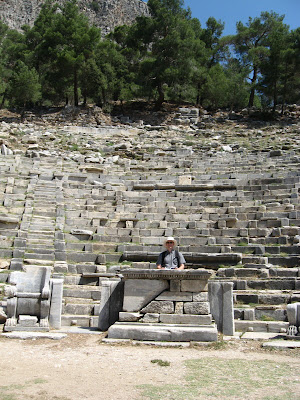 The prize for "favorite Turkish ruins experience" goes to Priene:
The prize for "favorite Turkish ruins experience" goes to Priene:- A steady breeze and lots of pine trees reminded us of central Oregon and kept us cool on a very hot day.
- There were very few other people at the site while we were there.
- Thanks to some excellent town-planning in the first millennium BCE., we were able to get our bearings quickly and navigate the site easily...once we found out where the excavated area started. The city grid, with main streets running east to west, is still visible on Google Earth's remarkably clear satellite photo of the ruins:

- The site is in an excellent state of preservation, and unlike Pergamum and Ephesus, the majority of the ruins reflect their Greek (rather than Roman) origin: "Apart from some minor alterations to the theatre and some of the other public buildings, the Hellenistic city [built in the 4th cent. BCE] was left untouched by the Romans....the modern visitor walks through the 2C BC" (Blue Guide, 232).

 A well-preserved Pyrtaneion:
A well-preserved Pyrtaneion: The Pyrtaneion--I now know after seeing several examples and doing a little background reading--was the administrative center of the Greek city, "housing its communal hearth...eternal flame [dedicated to the hearth goddess, Hestia], and public dining-room where civic hospitality was offered" (OCD 1268).
The Pyrtaneion--I now know after seeing several examples and doing a little background reading--was the administrative center of the Greek city, "housing its communal hearth...eternal flame [dedicated to the hearth goddess, Hestia], and public dining-room where civic hospitality was offered" (OCD 1268).Next to the Pyrtaneion is the Bouleterion or city council chamber:
 Near these buildings is a Greek inscription:
Near these buildings is a Greek inscription: (Curious about the Greek script? Interested in a transcription? See this post over at Evangelical Textual Criticism by Dirk Jongkind, who appears to have visited Priene shortly after we did.)
(Curious about the Greek script? Interested in a transcription? See this post over at Evangelical Textual Criticism by Dirk Jongkind, who appears to have visited Priene shortly after we did.)There were also several temples, the largest of which was the temple to Athena, now in some disarray:

 The (reconstructed) pillars are still impressive, however. According to the Blue Guide, this temple "became the model for Ionic architecture":
The (reconstructed) pillars are still impressive, however. According to the Blue Guide, this temple "became the model for Ionic architecture": But there are also signs of more ordinary life as you walk down the city streets...
But there are also signs of more ordinary life as you walk down the city streets...
 ...and gaze into the ruins of cookie-cutter, symmetrical houses, most of which were smaller than this large private dwelling:
...and gaze into the ruins of cookie-cutter, symmetrical houses, most of which were smaller than this large private dwelling: The town plan was built around square "insulae" units, most of which contained four private houses. Here's the Blue Guide again:
The town plan was built around square "insulae" units, most of which contained four private houses. Here's the Blue Guide again:These 3C and 4C BC houses have been compared with the 1C AD houses discovered at Pompeii and Herculaneum. they have many features in common. Both the Hellenistic and Roman builders used a design which proved itself effective all over the Mediterranean. Their houses were built to protect the occupants from the fierce heat of the summer sun and from the cold of winter.The houses were also very small by modern standards; their close proximity to each other illustrate how different our modern Western conceptions of personal space are from those of the ancient world.
Assuming the first Christ-believers met in houses, perhaps we should also consider how very different church in the first century would have been from most Christians' experience of church today.
Click here for the Turkey Travelogue Index.

No comments:
Post a Comment